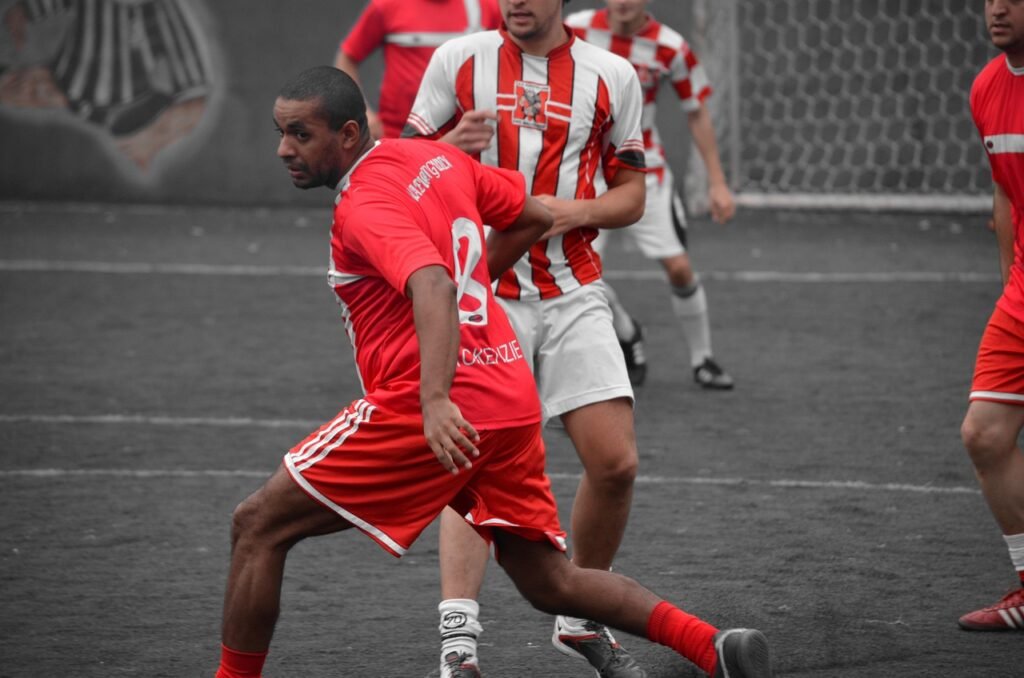Image by Adriana gois from Pixabay
Disclaimer: This article is for information only. It is not medical advice. Always talk to a doctor for health problems. If athlete’s foot gets worse or does not go away, see a doctor. Use treatments carefully and follow instructions.
Athlete’s foot is itchy and bothersome. It makes feet red and sore. You can fix it! This guide uses easy words. It’s simple, like a book for second graders. You’ll learn how to stop the fungus and keep it away. Let’s make your feet feel good again!
The Enemy Exposed: What You’re Actually Fighting
Athlete’s foot is not a bug. It’s a fungus. Tiny germs love your feet. They like warm, wet spots. Your feet are perfect for them. They eat dead skin and grow fast. They live anywhere on your feet.
These fungi are tough. They stay on floors, in shoes, or at pools. They can wait months to grow again. The main fungi are called Trichophyton rubrum and Trichophyton mentagrophytes. Don’t worry about their names. They eat keratin, a part of your skin, hair, and nails. They love the skin between your toes most.
Fungi make tiny seeds called spores. Spores wait for wet, warm places to grow. That’s why athlete’s foot comes back. You can stop them with the best athlete’s foot powder for comprehensive treatment. Knowing the enemy helps you win.
Spotting the Signs: Your Feet Are Trying to Tell You Something
Your feet show when something’s wrong. Athlete’s foot has clear signs. Check your feet every day.
Itching is the first sign. It’s a big itch. You want to scratch a lot. It starts between your toes, like the fourth and fifth toes. That’s where fungi hide.
Your skin looks bad. It peels or flakes, like paper. The skin between toes gets white and wet, like soggy bread. It feels bad.
Some get worse signs. Red spots hurt. Small blisters may pop up and burst. They leave sore spots. Cracks in skin sting. If it’s bad, feet smell like old socks. The smell is strong.
Athlete’s foot can spread. It may go to toenails. Nails turn yellow and thick. It can move to the bottom of your feet. They get dry and scaly. If you touch your feet, then your hands, it spreads there. Check feet daily to catch it early.
Quick Fixes That Actually Work: The Emergency Response
You want the itch to stop fast. Let’s fight the fungus with good treatments. They are easy to use.
The Antifungal Artillery
Antifungal creams kill fungi. You can buy them at stores. Two good ones are terbinafine and clotrimazole.
Terbinafine is strong. It stops fungi from growing. It attacks what fungi need to live. Put it on feet once a day for seven days. It works fast. You don’t need a doctor to buy it.
Clotrimazole is good too. It makes holes in fungi, so they die. Use it twice a day. Keep using it for one week after the itch stops. This kills all fungi. Follow the box instructions.
Some creams mix antifungals with itch relief. They help you feel better fast while killing fungi.
The Professional Heavy Artillery
Sometimes, store creams don’t work. That’s okay. A doctor can give stronger medicine.
Doctors have strong creams, like super terbinafine or ciclopirox. They work faster than store creams. They beat tough fungi.
For bad cases, doctors give pills. Pills like terbinafine or itraconazole fight fungi inside your body. They are strong. If fungi are in nails, pills work best. Nail infections take months to fix because nails grow slowly. Ask your doctor about powders. They know special ones that work great.
Natural Warfare: When Mother Nature Joins the Fight
Some natural treatments can help. They are not as strong as medicine but can help your plan.
Tea tree oil is good. It kills fungi. Mix one part tea tree oil with nine parts water. Put it on feet twice a day. Don’t use pure tea tree oil. It can burn skin. Test a small spot first.
Vinegar soaks help. Vinegar makes fungi unhappy. Mix one cup of white or apple cider vinegar with two cups of warm water. Soak feet for 15 minutes daily. Feet may smell like vinegar, but fungi hate it.
Garlic can work. It has allicin, which kills fungi. Crush garlic to make paste. Put it on for 30 minutes, then wash off. Test first because garlic can sting. Always wash and dry feet before using natural treatments.
Prevention: Building Your Defences
You beat the fungus. Now keep it away. These easy steps stop athlete’s foot from coming back.
Foot Hygiene That Means Business
Clean feet stop fungi. Wash feet daily with soap. Scrub between toes. Dry them well with a clean towel. Use a special towel for feet. Wash it in hot water to kill germs. Dry feet don’t let fungi grow.
Footwear Strategy
Shoes can help or hurt. Wear leather or canvas shoes. They let air in and keep feet dry. Plastic shoes trap water. Fungi love that. Don’t wear them all day.
Change shoes daily. Let each pair dry for 24 hours. Wet shoes help fungi grow. If you play sports, have two pairs of sneakers. Switch them to keep dry. Some use UV shoe cleaners. They kill fungi in shoes.
Sock Tactics
Good socks keep feet dry. Don’t use cotton socks. They hold water like a sponge. Use socks made of synthetic or wool. These pull water away from feet. Change socks if they get wet. Carry extra socks for long days. Some change socks twice a day to stay dry.
Environmental Awareness
Fungi love pools, showers, and gyms. Protect feet there. Wear flip-flops or shower shoes. They keep fungi away. Don’t share towels at home. Wash towels, socks, and sheets in hot water, at least 60°C. This kills fungi. Keep your bathroom clean and dry.
The Lifestyle Connection: Your Body as a Fortress
A healthy body fights fungi better. Make your body strong to keep athlete’s foot away.
Diet and Blood Sugar
Fungi love sugar. Too much sugar in blood helps fungi grow. This is big if you have diabetes. Eat less candy, soda, and white bread. Choose whole grains, vegetables, and beans. These keep blood sugar steady. A good diet helps stop fungi.
Immune System Support
A strong immune system stops infections. Help your body with these:
- Exercise daily. Walk, run, or play.
- Sleep enough each night. Rest keeps you strong.
- Relax to lower stress. Try reading or music.
- Eat foods with zinc, vitamin C, and B vitamins. They help skin and immunity.
A healthy body makes it hard for fungi to win.
When to Call in the Professionals
Sometimes, you need a doctor. Don’t wait if the fungus is stubborn. See a doctor if:
- Itch stays after two weeks of cream.
- You see red streaks, pus, swelling, or feel fever.
- You have diabetes or a weak immune system.
- Nails are yellow and thick.
Doctors have strong medicine. They stop fungi fast. Don’t let it get worse.
The Long Game: Staying Fungal-Free for Life
Beating athlete’s foot is great. Staying free is the goal. Make these habits part of life.
Maintenance Mode
Keep fungi away with daily care. If athlete’s foot comes back a lot, try these:
- Use antifungal powder daily.
- Put on antifungal cream once a week.
- Spray antifungal spray in shoes.
Check feet daily. Look between toes. Catch problems early to fix fast.
Seasonal Adjustments
Fungi like different seasons. In summer, it’s hot and sweaty. Keep feet dry. In winter, boots trap water. Change socks more. Use antifungal powder in boots to stop fungi.
Equipment Maintenance
Clean nail clippers and foot tools. They can hold fungi and start trouble again. Wipe with rubbing alcohol. Or buy new ones after treating athlete’s foot. Clean tools keep feet safe.
The Psychology of Prevention
Athlete’s foot can make you feel bad. Itchy feet stop you from swimming or going to the gym. A good plan helps you feel good. You can wear new shoes or go barefoot at home without worry.
Make simple habits daily. Wash and dry feet well. Wear good shoes and socks. Treat any itch fast. These steps are easy. They keep fungi away. You don’t need to be perfect, just keep at it.
Athlete’s foot is common. Many people get it. It’s easy to treat and prevent. You have the tools now. You know what to do. Your feet carry you every day. Keep them healthy and happy. With this plan, you’re in charge. The fungus doesn’t stand a chance.and happy. With this plan, you’re in charge, and the fungus doesn’t stand a chance.
Disclaimer: This article is for information only. It is not medical advice. Always talk to a doctor for health problems. If athlete’s foot gets worse or does not go away, see a doctor. Use treatments carefully and follow instructions.

Jennifer Marshall is a friendly and talented journalist who loves telling stories. She is an expert in writing biographies that make people’s lives shine. With clear and simple words, Jennifer creates engaging stories that everyone can enjoy. With 9 years of experience, her passion for writing helps her connect with readers and share inspiring tales.
